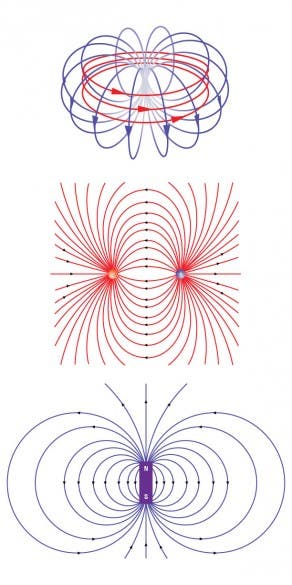Most certainly, one of the top goals in physics today is proving the existence of dark matter – the elusive form of matter that makes up 85% of all matter in the Universe. Many theories have been proposed and tested, however to this day we only have glimpses and possible hints of dark matter. A newly proposed theory claims dark matter is constructed of particles that have an abnormal, donut-shaped electromagnetic field known as an anapole. The proposal was then analyzed thoroughly by a pair of theoretical physicists at Vanderbilt University: Professor Robert Scherrer and post-doctoral fellow Chiu Man Ho. Their results seem to back-up the theory; a theory that is so elegant in its simplicity that it might actually be true.
Dark matter, as the name implies, is impossible to detect in normal conditions since it doesn’t absorb or emit light or energy. In fact, astronomical observations have basically ruled out the possibility that dark matter particles carry electrical charges. How do we know it exists then? Well, just because we can’t “see” dark matter, it doesn’t mean it’s not there. Observations have found there are consisting anomalies in the rotational rate of galactic clusters or that the rate that stars rotate around individual galaxies is similarly out of sync. Clearly there’s a dramatic gravitational effect that can not be accounted to normal matter, and as such the abstract concept of “dark matter” serves as the best explanation we have at the moment for these anomalies.
“There are a great many different theories about the nature of dark matter. What I like about this theory is its simplicity, uniqueness and the fact that it can be tested,” said Scherrer.

Comparison of an anapole field with common electric and magnetic dipoles. The anapole field, top, is generated by a toroidal electrical current. As a result, the field is confined within the torus, instead of spreading out like the fields generated by conventional electric and magnetic dipoles. (Michael Smeltzer / Vanderbilt)
Scherrer and Ho suggest that dark matter may be constructed of a type of basic particle known as the Majorana fermion – a type of particle like the electron and quark, which are the basic building blocks of matter. The particle’s existence was predicted in the 1930′s, however so far it has eluded detection in particle accelerators.
The Majorana is of great interest to physicists because it’s been predicted to be electrically neutral. This is important to note since dark matter don’t contain electrical charges, but might possess electric or magnetic dipole. In their paper, Scherrer and Ho have shown that these Majorana fermions are uniquely adapted to have an anapole, which causes the particles to have properties that vary from those of particles that have the more common fields possessing two poles. This would serve to explain why the particles are so hard to detect.
“Most models for dark matter assume that it interacts through exotic forces that we do not encounter in everyday life. Anapole dark matter makes use of ordinary electromagnetism that you learned about in school — the same force that makes magnets stick to your refrigerator or makes a balloon rubbed on your hair stick to the ceiling,” said Scherrer. “Further, the model makes very specific predictions about the rate at which it should show up in the vast dark matter detectors that are buried underground all over the world. These predictions show that soon the existence of anapole dark matter should either be discovered or ruled out by these experiments.”
According to Ho, “fundamental symmetries of nature” prevent Majorana fermions from obtaining any electromagnetic properties except the anapole. Particles with familiar electrical and magnetic dipoles, interact with electromagnetic fields even when they are stationary. Particles with anapole fields don’t. They must be moving before they interact and the faster they move the stronger the interaction. As a result, anapole particles would have been have been much more interactive during the early days of the universe and would have become less and less interactive as the universe expanded and cooled. Because dark matter is moving so much more slowly at the present day, and because the anapole interaction depends on how fast it moves, these particles would have escaped detection so far, but only just barely.
The researchers’ findings were reported in a paper published in the journal Physics Letters B.









